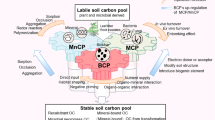Abstract
The input of labeled C into the pool of soil organic matter, the CO2 fluxes from the soil, and the contribution of root and microbial respiration to the CO2 emission were studied in a greenhouse experiment with continuous labeling of oat plants with 13CO2 using the method of the natural 13C abundance in the air. The carbon of the microbial biomass composed 56 and 39% of the total amounts of 13C photoassimilates in the rhizosphere and in the bulk soil, respectively. The contribution of root respiration to the CO2 emission from the soil reached 61–92%, including 4–23% of the rhizomicrobial respiration. The contribution of the microbial respiration to the total CO2 emission from the soil varied from 8 to 39%. The soil organic matter served as the major carbon-containing substrate for microorganisms in the bulk soil and in the rhizosphere: 81–91% of the total amount of carbon involved in the microbial metabolism was derived from the soil organic matter.
Similar content being viewed by others
References
I. V. Yevdokimov, R. Ruzer, F. Byugger, et al., “Interaction of Rhizosphere Microorganisms and Plant Roots: 13C Fluxes in the Rhizosphere after Pulse Labeling,” Pochvovedenie, No. 7, 852–861 (2007) [Eur. Soil Sci. 40 (7), 770–778 (2007)].
S. A. Blagodatsky and I. V. Yevdokimov, “Extractability of Microbial N as Influenced by C: N Ratio in the Flush after Drying or Fumigation,” Biol. Fertil. Soils 28, 5–11 (1998).
S. Bromand, J. K. Whalen, H. H. Janzen, and J. K. Schjoerring, “A Pulse-Labeling Method to Generate 13C-Enriched Plant Materials,” Plant Soil 235, 253–257 (2001).
P. C. Brookes, A. Landman, G. Pruden, and D. S. Jenkinson, “Chloroform Fumigation and Release of Soil Nitrogen: a Rapid Direct Extraction Method to Measure Microbial Biomass Nitrogen in Soil,” Soil Biol. Biochem. 17, 837–843 (1985).
J. L. Butler, P. J. Bottomley, S. M. Griffith, and D. D. Myrold, “Distribution and Turnover of Recently Fixed Photosynthate in Ryegrass Rhizospheres,” Soil Biol. Biochem. 36, 371–381 (2004).
W. Cheng, “Measurement of Rhizosphere Respiration and Organic Matter Decomposition Using Natural 13C,” Plant Soil 183, 263–268 (1996).
S. J. Grayston, D. Vaughan, and D. Jones, “Rhizosphere Carbon Flows in Trees, in Comparison with Annual Plants: the Importance of Root Exudation and Its Impact on Microbial Activity and Nutrient Availability,” Appl. Soil Ecol. 5, 29–56 (1996).
P. J. Hanson, N. T. Edwards, C. T. Garten, and J. A. Andrews, “Separating Root and Soil Microbial to Soil Respiration: A Review of Methods and Observations,” Biogeochemistry 48, 115–146 (2000).
H. M. Helal and D. R. Sauerbeck, “Influence of Plant Roots on’ and P Metabolism in Soil,” Plant Soil 76, 75–182 (1984).
L. Hiltner, “Uber neuere Erfahrungen und Probleme auf dem Gebiete der Bodenbakteriologie unter besonderer Berücksichtigung der Gründüngung und Brache,” Arb. Dtsch. Landwirtsch. Ges. 98, 59–78 (1904).
B. W. Huitsch, J. Augustin, and W. Merbach, “Plant Rhizodeposition — An Important Source of Carbon Turnover in Soils,” J. Plant Nutr. Soil Sci. 165, 397–407 (2002).
G. Johansson, “Below-Ground Carbon Distribution in Barley (Hordeum vulgare L.) with and without Nitrogen Fertilization,” Plant Soil 144, 93–99 (1992)
Y. Kyzyakov, “Separating Microbial Respiration of Exudates from Root Respiration in Nonsterile Soils: a Comparison of Four Methods,” Soil Biol. Biochem. 34, 1621–1631 (2002).
Y. Kuzyakov, “Separation of Root and Rhizomicrobial Respiration by Natural “Abundance: Theoretical Approach, Advantages, and Difficulties,” Eur. Soil Sci. 37Suppl. 1, 79–84 (2004).
Y. Kuzyakov and W. Cheng, “Photosynthesis Controls of Rhizosphere Respiration and Organic Matter Decomposition,” Soil Biol. Biochem. 33, 1915–1925 (2001).
Y. Kuzyakov and A. Larionova, “Root and Rhizomicrobial Respiration: A Review of Approaches to Estimate Respiration by Autotrophic and Heterotrophic Organisms in Soil,” J. Plant Nutr. Soil Sci. 168, 503–520 (2005).
Y. Kuzyakov and S. V. Siniakina, “Siphon Method of Separating Root-Derived Organic Compounds from Root Respiration in Nonsterile Soil,” J. Plant Nutr. Soil Sci. 164, 511–517 (2001).
Y. Kuzyakov, S. V. Siniakina, J. Ruehlmann, et al., “Effect of Nitrogen Fertilization on Below-Ground Carbon Allocation in Lettuce,” J. Sci. Food Agric. 82, 1432–1441 (2002).
A. A. Larionova, A. M. Yermolayev, S. A. Blagodatsky, et al., “Soil Respiration and Carbon Balance of Gray Forest Soils as Affected by Land Use,” Biol. Fertil. Soils 27, 251–257 (1998).
B. C. Liang, X. L. Wang, and B. L. Ma, “Maize Root-Induced Change in Soil Organic Carbon Pools,” Soil Sci. Soc. Am. J. 66, 845–847 (2002).
J. A. Palta and P. J. Gregory, “Drought Affects the Fluxes of Carbon to Roots and Soil in 13C Pulse-Labeled Plants of Wheat,” Soil Biol. Biochem. 29, 1395–1403 (1997).
E. A. Paul and F. E. Clark, Soil Microbiology and Biochemistry, 2nd ed. (Academic, San Diego, 1996).
M. Potthoff, N. Loftfield, F. Buegger, et al., “The Determination of 13C in Soil Microbial Biomass Using Fumigation-Extraction,” Soil Biol. Biochem. 35, 947–954 (2003).
P. Rochette, L. B. Flanagan, and E. G. Gregorich, “Separating Soil Respiration into Plant and Soil Components Using Analyses of the Natural Abundance of Carbon-13,” Soil Sci. Soc. Am. J. 63, 207–1213 (1999).
H. Santruckova, M. Bird, and J. Lloid, “Microbial Processes and Carbon-Isotope Fractionation in Tropical and Temperate Grassland Soils,” Funct. Ecol. 14, 108–114 (2000).
J. Swinnen, “Evaluation of the Use of a Model Rhizodeposition Technique to Separate Root and Microbial Respiration in Soil,” Plant Soil 165, 89–101 (1994).
E. D. Vance, P. C. Brookes, and D. S. Jenkinson, “An Extraction Method for Measuring Soil Microbial Biomass’,” Soil Biol. Biochem. 19, 703–707 (1987).
F. R. Warembourg and H. D. Esterlich, “Towards a Better Understanding of Carbon Flow in the Rhizosphere: a Time-Dependent Approach Using Carbon-14,” Biol. Fertil. Soils 30, 528–534 (2000).
Author information
Authors and Affiliations
Additional information
Original Russian Text © I.V. Yevdokimov, R. Ruser, F. Buegger, M. Marx, J.C. Munch, 2007, published in Pochvovedenie, 2007, No. 9, pp. 1086–1094.
Rights and permissions
About this article
Cite this article
Yevdokimov, I.V., Ruser, R., Buegger, F. et al. Carbon turnover in the rhizosphere under continuous plant labeling with 13CO2: Partitioning of root, microbial, and rhizomicrobial respiration. Eurasian Soil Sc. 40, 969–977 (2007). https://doi.org/10.1134/S1064229307090074
Received:
Issue Date:
DOI: https://doi.org/10.1134/S1064229307090074




